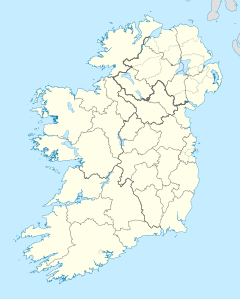Armagh rail disaster
| Date | 12 June 1889 |
|---|---|
| Time | ~10:45 |
| Location | Armagh |
| Coordinates | 54°21′39″N 6°36′45″W / 54.36083°N 6.61250°WCoordinates: 54°21′39″N 6°36′45″W / 54.36083°N 6.61250°W |
| Country | United Kingdom of Great Britain & Ireland |
| Rail line | Armagh-Newry line (closed 1933) |
| Cause | Runaway (inadequate application of manual brakes) |
| Statistics | |
| Trains | 2 |
| Passengers | ~940 |
| Deaths | 80 |
| Injuries | 260 |
| List of UK rail accidents by year | |
The Armagh rail disaster happened on 12 June 1889 near Armagh, Ulster, Ireland, when a crowded Sunday school excursion train had to negotiate a steep incline; the steam locomotive was unable to complete the climb and the train stalled. The train crew decided to divide the train and take forward the front portion, leaving the rear portion on the running line. The rear portion was inadequately braked and ran back down the gradient, colliding with a following train.
Eighty people were killed and 260 injured, about a third of them children. It was the worst rail disaster in the UK in the nineteenth century, and remains Ireland's worst railway disaster ever. To this day, it is the fourth worst railway accident in the United Kingdom.
At the time it was the worst rail disaster in Europe and led directly to various safety measures becoming legal requirements for railways in the United Kingdom. This was important both for the measures introduced and for the move away from voluntarism and towards more direct state intervention in such matters.
Armagh Sunday school had organised a day trip to the seaside resort of Warrenpoint, a distance of about 24 miles (38 km). A special Great Northern Railway of Ireland train was arranged for the journey, intended to carry about eight hundred passengers. The railway route was steeply graded and curved, and the first two and a half miles (4 km) from Armagh Station involved a steep continuous climb, up a gradient of 1 in 82 (1.22%) and then 1 in 75 (1.33%). Elsewhere on the line, there were gradients as severe as 1 in 70.2 (1.42%).
Asked to provide rolling stock for a special train to take 800 excursionists, the locomotive department at Dundalk sent fifteen vehicles hauled by a 'four-coupled' (2-4-0) locomotive; however the instructions to the engine driver were that the train was to be of thirteen vehicles. There were more intending passengers than anticipated and to accommodate the excursion, the Armagh station master decided to use all fifteen vehicles. The engine driver, who had never driven the route before (but had been over it with excursion trains when a fireman), objected to these instructions, saying that his instructions were that the train was to be of thirteen vehicles at most. According to the driver
...
Wikipedia

